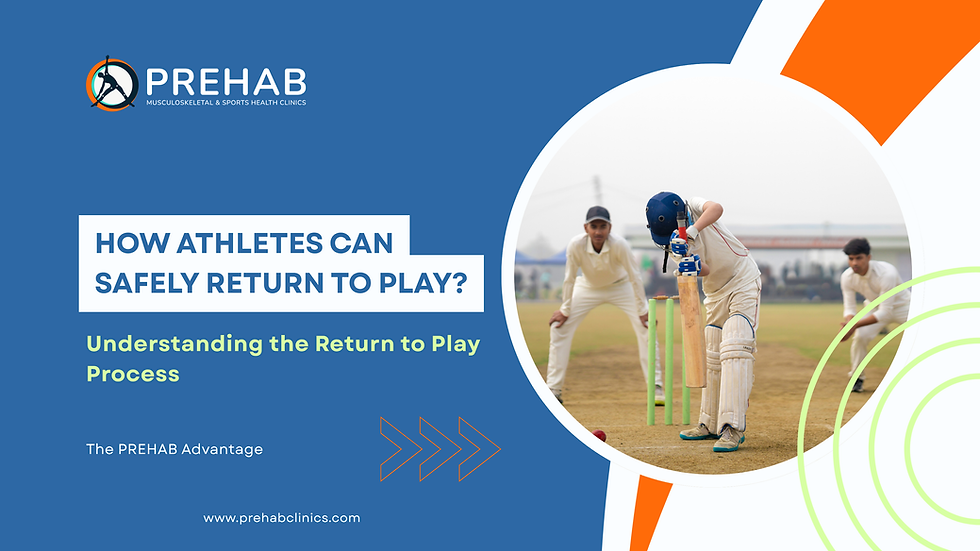Protecting Young Fast Bowlers: Understanding Spinal Stress Injuries in Cricket
- Prehab Healthcare
- May 5
- 3 min read
Updated: Jun 3
At first glance, cricket might seem like a graceful game. However, for young fast bowlers, especially in India, the physical toll can be immense.
The Rise of Spinal Stress Injuries
One growing concern is the rise in spinal stress injuries, even in players who aren’t overdoing their training. This pattern raises a critical question: Why are these injuries happening at such an alarming rate? The answer lies in a web of interconnected factors. These range from biomechanics and physical conditioning to hormonal balance and nutritional health, all of which play vital roles in building and maintaining strong, resilient bones.

Let’s break down these contributors and explore early intervention strategies to keep athletes strong, safe, and on the field.
Movement Matters: Mechanics and Muscle Imbalances
The repetitive strain of fast bowling places continuous pressure on the spine. Inefficient movement patterns exacerbate this issue. Poor landing posture, faulty mechanics, and preexisting injuries can all skyrocket the risk of injury.
Moreover, weak core strength and imbalanced hips can throw off alignment. This overloads the spine and increases the likelihood of injury.
What Can Be Done?
Early biomechanical screening is essential. Sports-specific strength programs and ongoing technical refinement with experienced physiotherapists and coaches are crucial. Technological analysis tools reveal subtle strength asymmetries. This individualized correction can help prevent injuries before they occur.
The Hidden Impact of Adolescence on Growth and Performance
Teenage athletes face rapid physical changes during growth spurts. Hormonal shifts and evolving bone structure create unique vulnerabilities. These natural processes are vital for development but can also weaken skeletal integrity if improperly managed.
Hormones like oestrogen, testosterone, and growth hormone regulate bone growth and repair. Fluctuations during adolescence can affect bone health, especially when unmanaged. For female athletes, irregular periods or amenorrhea may signal reduced oestrogen levels—a red flag for bone fragility. Underlying health conditions and medications can also disrupt bone metabolism. Timely medical attention and hormonal assessments are essential in these cases.
Fueling the Framework: Nutrition as Structural Defense
Nutrition is a critical component of bone health. Food isn’t just fuel; it’s a building block for stronger bones. Insufficient intake of calcium, vitamin D, protein, magnesium, and phosphorus can compromise skeletal strength.
Interestingly, an excess of protein without proper balance can negatively affect bone health. Educating young cricketers on proper dietary habits during high-growth periods is a foundational aspect of achieving peak performance and injury prevention.
Training Smarter: Less is More
Contrary to popular belief, spinal stress injuries aren’t always due to excessive training. Often, they arise from inefficient recovery, inconsistent training plans, or abrupt spikes in intensity. Load management is essential. It goes beyond merely reducing training volume.
Organizing Training with Intention
Consider these strategies:
Structured rest days are critical.
Active recovery helps maintain fitness levels without overloading the body.
Gradual load progression focuses on small, manageable increases.
Clear adaptation windows allow the body time to adjust.
Doing these things right allows the spine to recover and adapt, making athletes more durable for the long run.

Don’t Wait for Pain: The Importance of Early Detection
It's tempting to ignore discomfort until it becomes problematic. However, spinal stress injuries develop gradually. Regular screening, particularly during growth years, can catch early signs of dysfunction.
Sports physiotherapists evaluate movement patterns, muscle symmetry, and early red flags. This enables preventive interventions before serious damage develops.
Collaboration is paramount. Skill coaches, physiotherapists, nutritionists, and strength trainers should work together. This team effort creates tailored, sport-specific plans that support performance while minimizing injury risk.
Recovery: A Milestone-Driven Process
Despite taking precautions, injuries may still occur. The approach to recovery is crucial. Healing from spinal stress injuries requires:
Initial offloading, or rest, to allow healing.
Progressive strength and mobility work to rebuild capacity.
Correction of faulty mechanics to eliminate the roots of the problem.
Gradual reintroduction to sport-specific activities.
The return-to-play phase is especially delicate. Rushing back without correcting underlying causes can lead to reinjuries, forcing the rehab process to restart.
Conclusion: The Spine as a Long-Term Investment
Spinal stress injuries are complex but not inevitable. A holistic, proactive approach can help. This includes integrating biomechanics, hormones, nutrition, recovery, and collaboration. With these strategies, young cricketers can enjoy long, rewarding careers while protecting their spinal health.
In sports, as in life, prevention is far more powerful than repair.
For more information on preventing injuries, check out injury prevention strategies.



Comments